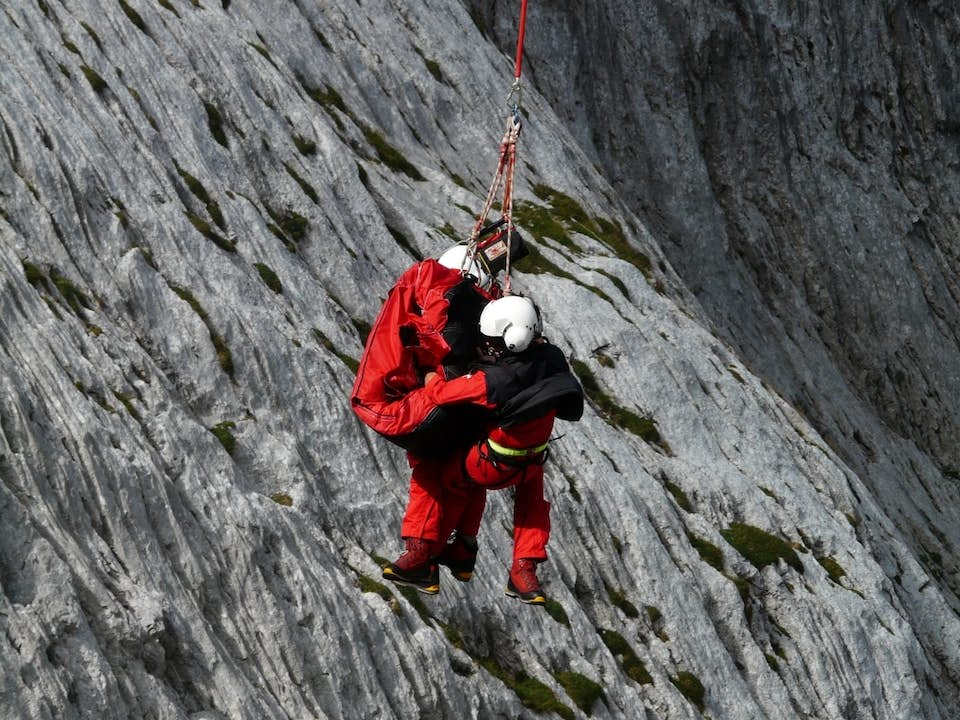Search and rescue helicopters have the range, mobility, precision, and hoisting capabilities required to perform lifesaving search and rescue missions and aid disaster relief efforts within devastated communities and hard-to-reach locations.
That’s why they’re called upon to perform in the most harrowing of emergencies, from natural disasters like hurricanes and typhoons to unforeseen crashes and explosions.
Below, we’ll explain why helicopters are one of the most effective and sought-after search and rescue units for debris field searches, search and rescue missions, and disaster relief efforts.
How helicopters aid debris field searches and search and rescue missions
Search and rescue helicopters can be instrumental in finding debris fields and survivors after a natural disaster has struck or an aircraft or water vessel has crashed or disappeared.
Debris fields are areas that contain debris of wreckage or material from disastrous events such as:
- an airplane or helicopter crash
- water vessel sinking
- building collapse or explosion
- catastrophic weather event
- any other event that caused a once-whole object to be separated into various pieces of debris
Experienced search and rescue pilots and their crew members are trained to spot debris fields while flying overhead. Finding these fields in a timely manner is often the differentiating factor that helps save lives.
For example, after Hurricane Dorian devastated the Bahamas in September of 2019, a helicopter pilot volunteering in the aftermath discovered 30-40 survivors in a debris field while flying over Little Abaco Island.
According to MEDIC Corps, “the village had been overlooked because it was located off main roads, and the residents didn't have vehicles or speak English. The stranded people were in desperate need of supplies and support.”
If it hadn’t been for the pilot’s aerial debris field search, these people would not have received the medical attention and support they so urgently required. In fact, they may not have been discovered at all.

Why search and rescue helicopters are the ideal search and rescue unit for vital missions
Search and rescue helicopters are one of the most effective search and rescue units for a number of reasons:
- Their slow speed and ability to hover make them the most effective vessel for targeting smaller areas and performing close-up inspections of land and water
- Their ability to access and land in hard-to-reach locations and operate from ships enables them to administer aid to survivors long before ground units can arrive
- They are capable of flying for several hours and for hundreds of miles at a time, so they can cover vast distances quickly and perform hours of rescue operations without needing to refuel
- Their size, power, and agility mean they’re equipped to perform well in potentially hazardous locations, such as in remote areas, high altitudes, high temperatures, and elevated atmospheric pressure
- They’re designed to brave the elements and remain stable in furious crosswinds and moderately threatening climates
- They are capable of carrying thousands of pounds of food, water, and supplies
- They are typically outfitted with the necessary hoisting devices to enable efficient search and rescue and delivery operations
At Helicopter Express, we prioritize life-saving search and rescue missions
“Lifesaving missions are a priority,” shares Jon Bourke, Director of Quality Assurance at Helicopter Express. “We have to be able to go from one mission to another rather quickly. Say, for example, we’re out on a USFS fire with both helicopters and we get a rescue call. So, we fly back, put our park service hat on, and now we’re working with the rescue rangers.”
Our diverse fleet of search and rescue helicopters and skilled crew members are ready and able to get to work at a moment’s notice.
We currently provide support to a number of services, including the National Park Service in Grand Teton National Park, a challenging environment made up of 310,000 acres, 50 miles of wild and treacherous river, and the 12 jagged peaks of the Teton mountain range.
Our pilots are prepared to work closely with groups of rangers and other vital units to perform critical, lifesaving missions—including short-haul rescues (live human external loads)—in even the most tumultuous environments.
How helicopters aid disaster relief efforts
When disaster strikes, such as a tornado, earthquake, hurricane, wildfire, or other natural disaster or catastrophe, the impacted communities often need urgent help. They may require food, water, medical supplies, doctors, and volunteers to help sort through the wreckage, deliver essential supplies, and administer medically necessary aid to the wounded.
Helicopters have long been an indispensable resource in the aftermath of disasters. When Hurricane Katrina struck New Orleans in 2005, for example, survivors experienced a severe scarcity of food and water. According to Coast Guard officials, “addressing food and water shortages in the days following Katrina's landfall became an important part of rescue operations.”
Helicopters were used to transport food and water to the devastated city, and disaster relief personnel distributed the supplies. These aircraft also delivered water to the Superdome on a daily basis, where survivors gathered to await help.
For 17 days after the hurricane struck New Orleans, helicopters assisted in rescues and evacuations of survivors. The Coast Guard alone conducted 24,135 rescues and evacuated 9,409 people from hospitals via helicopters and water vessels.
According to the U.S. Navy’s National Search and Rescue Manual Volume 1: National Search and Rescue System, helicopters often provide the quickest form of assistance when survivors require transport to nearby medical facilities for treatment of life-threatening injuries.

Our fleet is prepared to provide helicopter relief within hours of receiving the call
When disaster strikes, Helicopter Express is on standby to provide helicopter relief. Our highly skilled pilots are experienced in supplying food, water, medicine, personnel, and other essential resources to expertly aid communities in crisis. Our full fleet of crane helicopters is fully equipped to meet the critical needs of cities devastated by natural disaster.
If you’re interested in learning more about our contracted disaster relief services, contact our Atlanta-based helicopter service experts today.

